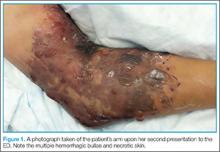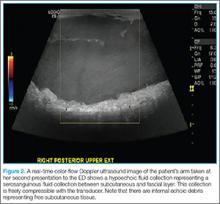Case
A 32-year-old previously healthy woman presented to the ED with right upper arm pain and swelling of 6 days duration. According to the patient, the swelling began 2 days after she sustained a work-related injury at a coin-manufacturing factory. She stated that her right arm had gotten caught inside of a rolling press while she was cleaning it. The roller had stopped over her upper arm, trapping it between the roller and the platform for several minutes before it was extricated. She was brought to the ED by emergency medical services for evaluation immediately following this incident. At this first visit to the ED, the patient complained of mild pain in her right arm. Physical examination at that time revealed mild diffuse swelling extending from her hand to her distal humerus, with mild pain on passive flexion, and extension without associated numbness or tingling. Plain films of her right upper extremity were ordered, the results of which were relatively unremarkable. She was evaluated by an orthopedist, who ruled out compartment syndrome based on her benign physical examination and soft compartments. She was ultimately discharged and told to follow up with her primary care provider.
Over the course of 48 hours from the first ED visit, the patient developed large bullae on the dorsal and volar aspect of her forearm, elbow, and upper arm with associated pain. In addition to dark discolorations of the skin over her affected arm, she noticed that the bullae had become numerous and discolored. These symptoms continued to grow progressively worse, prompting her second presentation to the ED.
With respect to the patient’s history, she denied taking any medications and did not have any significant medical or surgical history. She also denied any new food exposure, infections, or insect bites. Physical examination revealed a young woman who was uncomfortable but cooperative. On inspection, she had multiple hemorrhagic bullae extending circumferentially from the mid-upper arm to her mid-forearm with lightly ecchymotic skin that was more prominent on the medial aspect of her arm (Figure 1). There was notable fluid collection, most prominently in the posterior aspect of her arm underneath the area of greatest skin necrosis. The compartments were flaccid and compressible, and radial, ulnar, and brachial pulses were palpable. The patient complained of diffuse paresthesias and decreased sensation in radial, median, and ulnar nerve distribution. Motor strength of the flexor digitorum superficialis, profundus, extensor policis longus, and extensor carpi radialis remained 5/5. Laboratory evaluations, which included coagulation studies, were normal with the exception of a minimally elevated creatinine kinase at 239 IU/L (normal, 20-210 IU/L). The patient was evaluated by a trauma surgeon and subsequently underwent ultrasound evaluation (Figure 2) and computed tomography (CT) with intravenous (IV) contrast of the affected arm. Both studies revealed an extensive fluid collection centered in the subcutaneous fat extending from the mid-forearm to the humeral head, consistent with an internal degloving injury.The patient was taken to the operating room and underwent debridement and resection of the circumferential necrotic skin and subcutaneous tissue in her right arm, and the placement of a skin graft with overlying wound vacuum-assisted closure. During the procedure, a large amount of serosanguinous fluid was drained and cultured, and was found to be sterile. Due to the size of her injury, she underwent two additional episodes of debridement and graft placement over the course of the next 2 weeks.
Discussion
First described in the 1850s by the French physician Maurice Morel-Lavallée, Morel-Lavallée lesion is a rare, traumatic, soft-tissue injury.1 It is an internal degloving injury wherein the skin and subcutaneous tissue have been forcibly separated from the underlying fascia as a result of shear stress. The lymphatic and blood vessels between the layers are also disrupted in this process, resulting in the accumulation of blood and lymphatic fluid as well as subcutaneous debris in the potential space that forms. Excess accumulation over time can compromise blood supply to the overlying skin and cause necrosis.2 Morel-Lavallée lesion is missed on initial evaluation in up to one-third of the cases and may have a delay in presentation ranging from hours to months after the inciting injury.3
Morel-Lavallée lesions typically involve the flank, hips, thigh, and prepatellar regions as a result of shear injuries sustained from bicycle falls and motor vehicle accidents.4 These lesions are often associated with concomitant acetabular and pelvic fractures.5 Involvement of the upper extremities is unusual. Typically, presentation consists of a fluctuant and painful mass underneath the skin which increases over time. The overlying skin may show the mechanism of the original injury, for example, as abrasions after a crush injury. The excessive skin necrosis and hemorrhagic bullae seen in this particular case is a very rare presentation.


